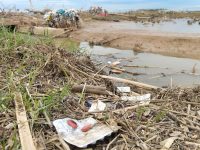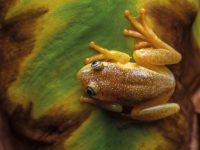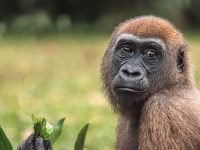Photography and biodiversity awareness
The use of images in conservation
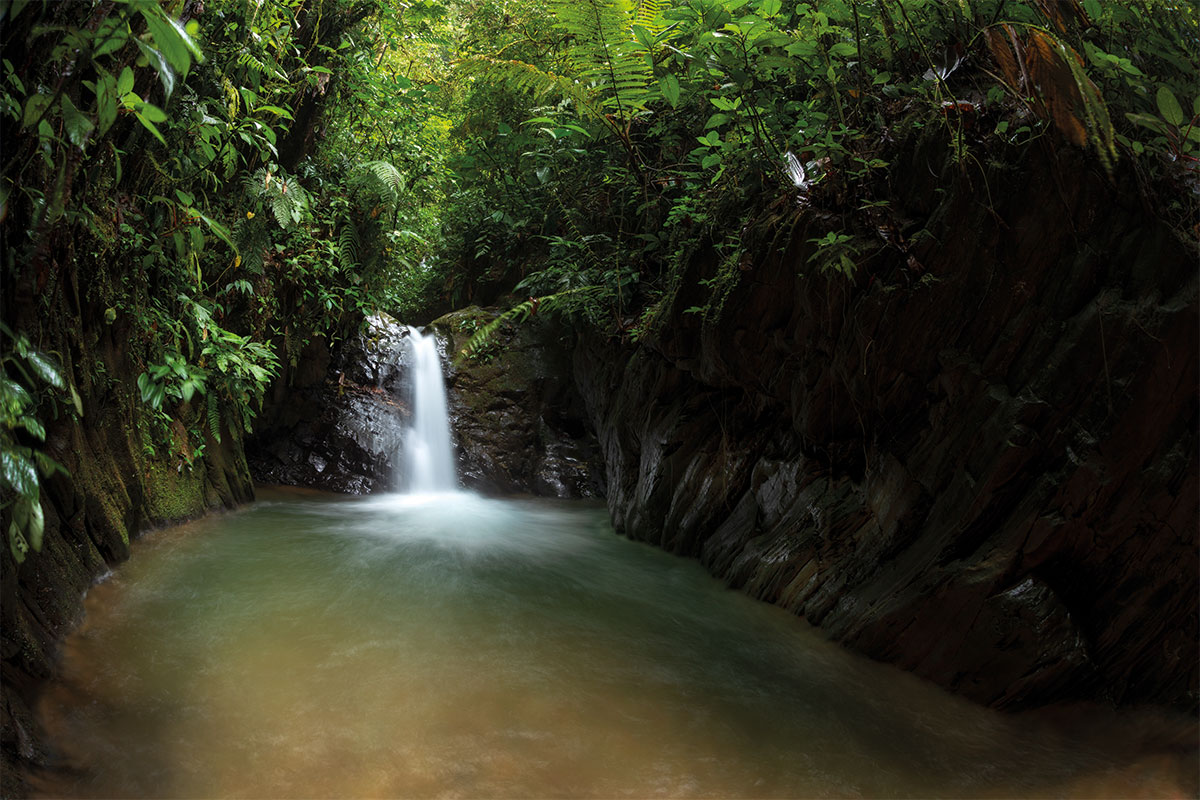
Since its inception, photography has played an important role as a documentary tool. It has been used to communicate and disseminate biodiversity research and conservation projects in different parts of the world. Today, the extraordinary technological development and popularity of photography has allowed it to be used to collect data for different types of scientific projects and to facilitate a much more fluid exchange of information between the scientific community and the public, for example in citizen science programmes. However, a paradigm shift is now being proposed for photography to move beyond its purely artistic sense to reveal its informative and knowledge-generating potential in the field of conservation.
Keywords: photography, conservation, history, research, science.
Photography has emerged as a tool that allows us, among other things, to capture reality or to document it unambiguously. Photographs were seen as unique evidence of a place or a moment in history and were therefore used as a source of information. This positioned photography as a key element in the field of biology and conservation.
In the history of photography, some of the earliest series of images to be published on a mass scale were taken by the Russian explorer Gombozhab Tsybikov during his expedition to Tibet between November 1899 and April 1902, funded by the Russian Geographical Society. Some of his photographs, along with others by the Kalmyk traveller Ovshe Norzunov, were published in National Geographic Magazine in 1905. They showed the mysterious city of Lhasa, the religious and political centre of Tibet, then a remote place unknown to most of the world. Their images had a huge social impact. This prompted National Geographic to continue publishing photographs in what was at the time a ground breaking visual style, sowing the seeds of the worldwide fame the magazine would enjoy just a few decades later.
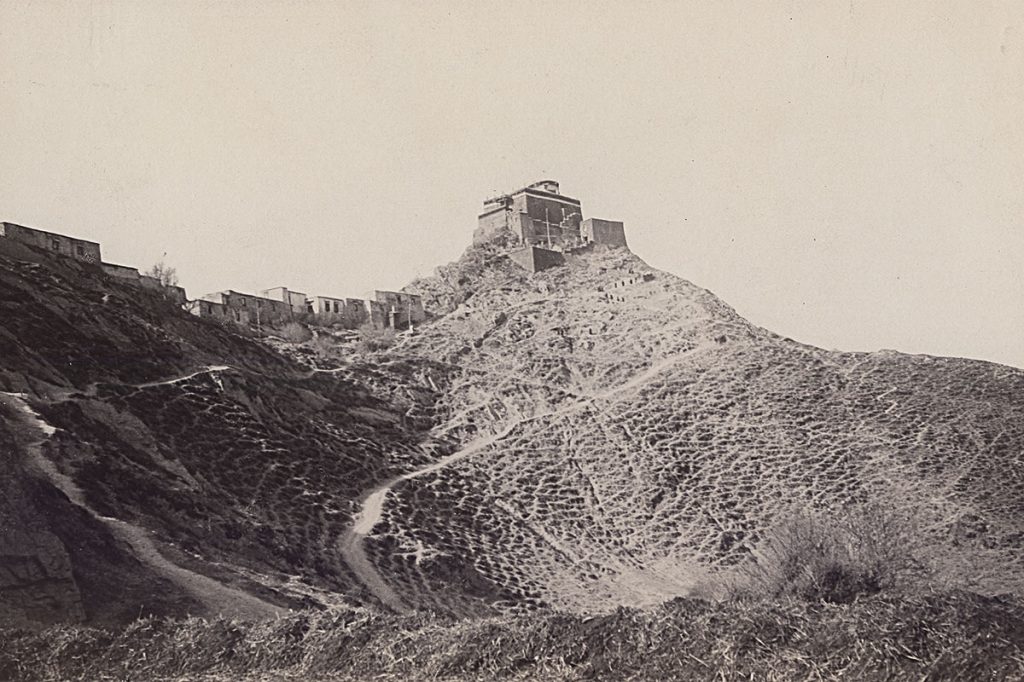
Some of the first series of images to be published en masse were those taken by the Russian explorer Gombozhab Tsybikov during his expedition to Tibet between 1899 and 1902. Some of his photographs, along with others by the Kalmyk traveller Ovshe Norzunov, were published in the National Geographic Magazine. These photographs showed the mysterious city of Lhasa, the religious and political centre of Tibet, then a remote place unknown to most of the world./ World Digital Library
This was one of the many examples of the great documentary value of the photographic camera, a technology that had been constantly evolving since its beginnings in 1824 with the successful experiments of Nicéphore Niépce, followed by those of Louis-Jacques-Mandé Daguerre, who in 1839 invented the daguerreotype (a technique capable of capturing a real, high-resolution image on a copper plate), and William Henry Fox Talbot in 1841, who invented the calotype (the first negative-positive process). Together with others such as John Herschell, Richard Maddox, and Charles Bennett, they made relatively advanced photographic technology possible by the end of the 19th century, although it was clearly limited to a few users.
In the 20th century, photography began to play an increasingly important role in the documentary field. In addition, technological advances made colour imaging possible in the first decade of the century. Some major international media, such as National Geographic, made a strong commitment to printing colour photographs, providing a fundamental substrate for the growth of photography and a late but important consideration of the mass dissemination of images as a communication tool. In this way, National Geographic became an iconic pioneer in the field of nature and conservation, one that would later be emulated by many others, with an entirely new editorial line that brought the natural world closer to the general public.
Photography at the dawn of conservation movements
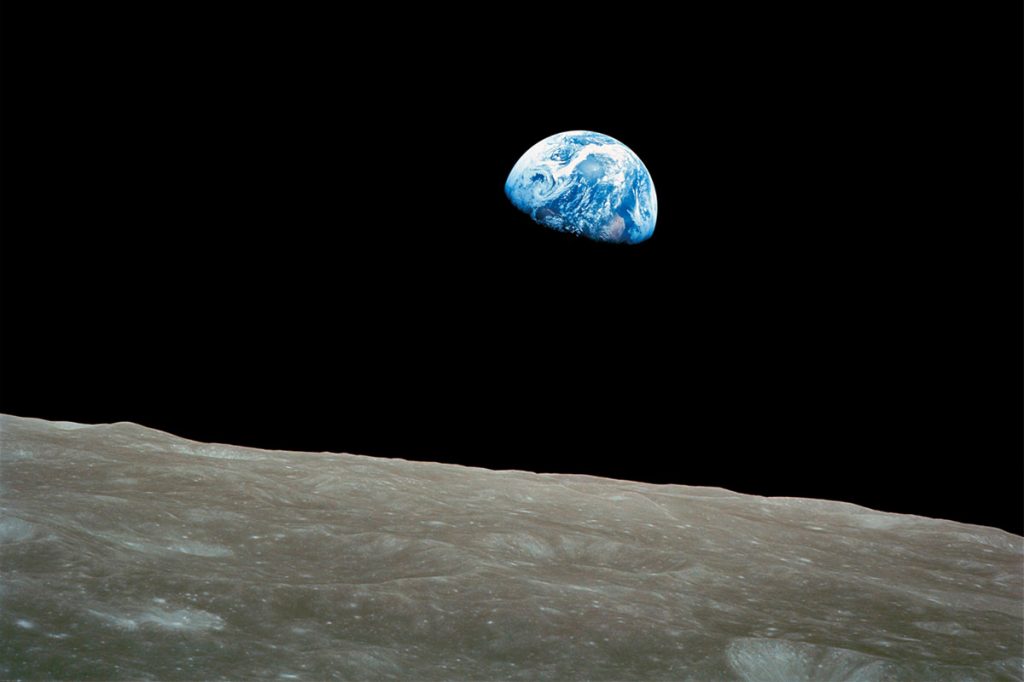
One of the most iconic images of all time was taken by astronaut William Anders in 1968. This photograph of the Earth, called Earthrise, was taken from the Apollo 8 shuttle. When Anders saw the Earth appear on the horizon, he took a first snapshot. He later recounted the experience by saying: «We came all this way to explore the Moon, and the most important thing is that we discovered the Earth»./ NASA
The first steps in photography that led to the environmental and conservation movements of the late 20th century came after World War II. One of the most iconic images was taken by astronaut William Anders on 24 December 1968. This image of the Earth, called Earthrise, was taken from the Apollo 8 shuttle on a mission to map the lunar surface. When Anders saw the Earth appear on the horizon, he took a first snapshot with a state-of-the-art Hasselblad 500 EL camera equipped with a 250 mm lens and 70 mm Kodak Ektachrome film. This first image was in black and white. However, the desire to get a better snapshot led Anders to ask his colleague Jim Lovell to change the film to colour. After some haggling between the two astronauts, Anders adjusted the camera settings (250 mm, 1/250 s at f/11) and captured the image that would then go down in history. In Life magazine, the renowned photographer Galen Rowell called it one of the hundred photographs that changed the world. But this image did not have an immediate effect. Its impact came a few years later, when it inspired the explosion of the conservation and environmental movements of the time. Anders summed up the experience by saying: «We came all this way to explore the Moon, and the most important thing is that we discovered the Earth».
Photography as a cornerstone of conservation
At the end of the last century, the development of photography reached a technical level that made it accessible to a very wide audience. The environmental and conservation movements found an ally in photography. Its proven value as a means of propaganda and dissemination would only increase over the years. Photographic projects with a strong conservation focus began to appear all over the world. In the mid-1970s, some photographers, such as the American Emmet Gowin, adopted an aerial perspective to show the impact of human activity on the natural environment. This type of photography was later adopted by renowned photographers such as the environmental activist and science communicator Yann Arthus-Bertrand, who published a famous series of images entitled Earth from above. Other contemporary projects, such as Nature’s Edge (USA), used aerial photography to show the contrast between natural and man-made environments or, from another perspective, our impact on the environment. Gowin defined photography as a tool for dealing with elements that everyone knows about but no one pays attention to, an idea that has underpinned much of the conservation movement since.
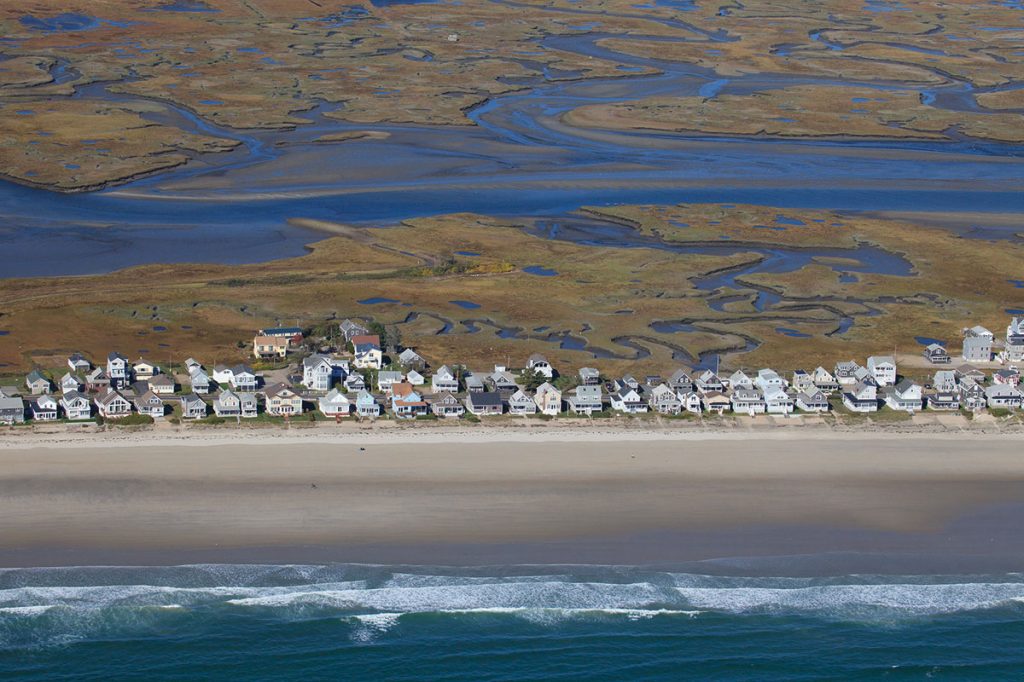
In the mid-1970s, some photographers chose an aerial perspective to show the impact of human activity on the natural environment. Other contemporary projects, such as Nature’s Edge (USA), use aerial photography to show the contrast between the natural and man-made environment, or from another perspective, our impact on the environment. This 2017 picture shows coastal housing at the Rachel Carson National Wildlife Refuge, Maine (USA). / Nature’s Edge
Over the years, photography has become a powerful tool. As the writer Susan Sontag put it: «Like a pair of binoculars with no right or wrong end, the camera makes exotic things near, intimate; and familiar things small, abstract, strange, much farther away» (Sontag, 1977/2005, p. 234). This is the potential of photography to support not only conservation causes, but also conservation biology, inviting us to learn about organisms and protect a wide variety of ecosystems, including species that inhabit our own territories and require active protection (Groom et al., 2006).
Many conservation projects have been disseminated and sometimes sustained over time thanks to the use of images that have had a significant impact on a heterogeneous audience. For example, the International Union for Conservation of Nature was founded in 1948 at the Château de Fontainebleau in France under the auspices of UNESCO. This organisation is one of the most important conservation institutions in the world, and from the beginning it has considered photography as one of its main strategies for environmental communication and awareness.
Another emblematic case of the power of photography in developing conservation projects was that of the gorillas of the Virunga Mountains, a volcanic range that runs through Rwanda, the Democratic Republic of Congo, and Uganda. The American zoologist Dian Fossey spent much of her life studying the social behaviour of the eastern gorilla (Gorilla beringei) in the wild and recorded her observations in the book Gorillas in the mist (Fossey, 1983). In 1970, this story became known through a photographic report published in National Geographic entitled «Making friends with mountain gorillas», which included images taken by photographer Robert M. Campbell. Fossey was confronted with the problem of poachers threatening the survival of gorillas, which were being captured for the practice of sumu (black magic) or to sell their offspring to zoos (Fossey, 1983). The impact of Campbell’s photographs demystified gorillas as wild and dangerous animals and led to action and financial support to save the species from extinction. Fossey was murdered in 1985, shortly before she was to make an autobiographical film to raise money to continue her research. The production was eventually directed by Michael Apted, starring Sigourney Weaver, and released in 1988. Fossey’s legacy lives on today in the Dian Fossey Gorilla Fund International.
Along with Dian Fossey, Jane Goodall and Biruté Galdikas were also studying primates at the same time: these three women were known as the «trimates». Goodall worked with chimpanzees and Galdikas with orangutans. Both women approached their research with a strong sense of conservationism, supported by the use of photography as a mainstay of environmental awareness and fundraising. Some of Goodall’s images of chimpanzees, taken by her partner at the time, photographer Hugo van Lawick, became iconic in conveying the bond that can exist between humans and other creatures on this planet. Galdikas was also accompanied by her then-husband, photographer Ron Brindamour. In all three cases, photography was key to demonstrating to investors and the general public the need for continued conservation of the species being studied.
Applications of photography in data capture
As well as being a medium for the dissemination of information, photography is also an exceptional tool for data collection. It is used in a wide variety of disciplines related to conservation biology but is too often overlooked. One of the best known examples is the use of photo-trapping. This photographic technique has been around for over a century. The first such wildlife photographs were taken by the American photographer George Shiras in the early 20th century. Shiras, considered one of the fathers of so-called nature photography, was an avid hunter, but also a naturalist and one of the driving forces behind the replacement of rifle hunting with photographic «hunting». As part of his conservation efforts, Shiras advocated the use of images as surrogate trophies for the animals themselves. The campaign was supported by many photographers and celebrities of the time, including Theodore Roosevelt himself. In the decades that followed, the use of photo-trapping continued to grow in popularity, but not in the way Shiras had expected. The technique became very popular in the hunting world as it made it easier to locate potential prey, a trend that continues to this day.
In addition, the advent of digital photography in photo-trapping overcame equipment limitations on the number of images that could be captured. There was also the possibility of making video recordings, which proved beneficial to the scientific community. A large amount of highly autonomous equipment could be purchased at low cost, facilitating the design of much more ambitious and robust research projects. In addition, recent advances in image processing, e.g., using machine learning techniques and specialised software, made it possible to optimise the handling and organisation of large amounts of data. For example, a study by Tabak et al. (2019) demonstrated the high efficiency of photo-trapping for classifying animal species, with processing capacities of 2,000 images per minute and 98 % accuracy in species identification.
Photo-trapping allows for the identification and even differentiation of individuals of the same species, which is particularly useful in large mammal conservation projects. There are several examples around the world, such as for the brown bear (Ursus arctos) in Spain (supported by Fundación Oso Pardo, or FOP, and Fondo para la Protección de los Animales Salvajes, or FAPAS) or tiger (Panthera tigris) in Malaysia (Wang & MacDonald, 2009). Photo-trapping has also been part of population density studies (Rovero & Marshall, 2009), wildlife inventories (Burton et al., 2015), and animal behaviour studies (Rowcliffe et al., 2014), among others, making it a growing method in ecology and conservation biology.
In recent decades, photography has also been integrated with unmanned aerial vehicles, commonly known as drones or remotely piloted aircraft systems (RPAS). The ability to conduct relatively inexpensive, pilotless flights, in some cases without the need for a special licence, has made interesting contributions, for example, to the census of populations of animals such as large mammals, crocodiles, and sea turtles (Ivosevic et al., 2015). In this way, the prohibitive cost of similar work – done with crewed flights – has been reduced for low-budget projects. In addition, the use of drones can increase the accuracy in measuring some variables, such as wildlife counts (Hogdson et al., 2018), which previously had to be done by humans. The use of high-resolution aerial photography also opens the possibility for applications in the field of ecology, and represents a very important advance in operations related to the monitoring and management of natural resources (Mangewa et al., 2019) and in the detection of environmental damage, as in the case of deforestation (Paneque-Gálvez et al., 2014). Highly detailed mapping and the use of different types of sensors is now possible, allowing access to multiple measurements and combined interpretations of information such as, for example, mapping coral reefs using drone imagery and combining it with information from laser sensors (LiDAR – light detection and ranging) for bathymetry (Collin et al., 2018).
Today, the use of photography dominates our daily lives. With the popularity of mobile phones, the average person now has a powerful camera in their pocket. The implications for science are huge. For example, through participatory citizen science projects in which the public directly report biodiversity information. One of the most iconic examples of this type of initiative is the City Nature Challenge. This activity, sponsored by the Natural History Museum of Los Angeles County and the California Academy of Sciences, began as a way to popularise citizen science through a competition between the cities of Los Angeles and San Francisco in the United States. The initiative aimed to understand urban biodiversity through citizen registration and participation. The results of the first edition in 2016 were surprising. In just one week, around 20,000 reports were received, with the participation of more than 1,000 people. Around 1,600 species were catalogued in each city. Given the success of this campaign, in 2017 it became a national event with the participation of 16 cities. In subsequent editions it became a global event, which in 2021 attracted the attention of 419 cities in 44 countries, with 1,270,000 observations, 45,300 species recorded, and the participation of 52,000 observers.
This example allows us to visualise the scope and potential of this type of initiative, and also to highlight the amazing speed of information exchange through photography. Although they are not as widespread, there are many examples of citizen participation that go beyond the collection of information and involve participation in various tasks, such as classifying images for use in species distribution models, characterising bird and amphibian life, or monitoring flora. This facilitates the integration of citizens as actors in the registration work and stimulates a higher level of environmental awareness, which will be crucial for direct conservation action in the field. These processes promote the development of knowledge with great agility. In addition to the large amount of images obtained, their processing is becoming a challenge, and it is in this scenario that the use of artificial intelligence is becoming increasingly efficient (Norouzzadeh et al., 2018).
However, the «noise» in the signal should not be ignored: fake images or images taken from inappropriate perspectives, with excessive use of filters, modified or inaccurately geotagged. In addition, information about certain species disseminated through inappropriate channels – via social networks outside the scientific community – can be counterproductive not only for conservation biology, but also for the environmental awareness of the non-expert public. For example, a recent study has highlighted the negative impact that the dissemination of biased information has had on vultures (Lambertucci et al., 2021). Lambertucci and colleagues discussed how a vulture attack on an animal, which is a rare event, can be publicised in such a way as to create a misperception of vulture behaviour among the public, who end up misinterpreting this rare event as a common occurrence. Influencing public perception in this way significantly impacts the conservation status of some species such as vultures, and other animals with «bad press» such as snakes, bats, and insects, among others. While certain information associated with an endangered species, such as a photograph and location, can be unbelievably valuable data for conservation programmes, it can also be used for opposing interests such as poaching or illegal wildlife trade.
The end of the photographic era?
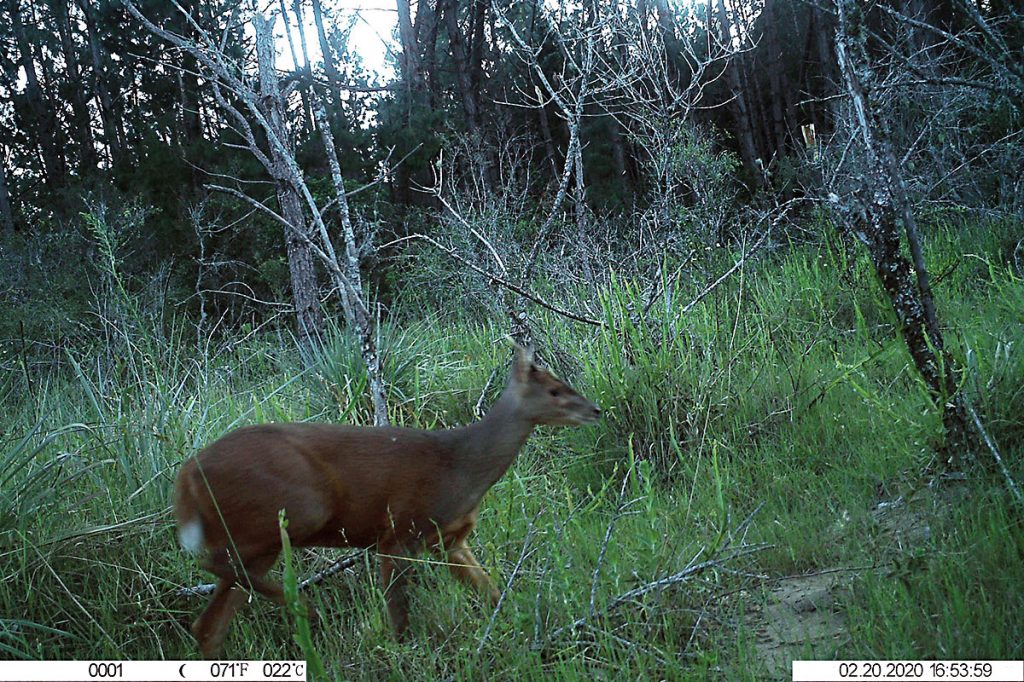
Photo-trapping allows for the identification and even differentiation of individuals of the same species, which is particularly useful in large mammal conservation projects. Image taken with an automatic camera showing a brown brocket (Mazama gouazoubira). / S. Carreira
While there are still organisations and events that preserve the spirit of conservation photography in its purest sense, such as the International League of Conservation Photographers or prestigious competitions such as Wildlife Photographer of the Year or the World Press Photo, among others, the original purpose of photography is generally being lost. With its massification and low cost, the original aim of portrayal with beauty has been distorted to communicate through images that are generally technically good (in terms of megapixels and optics) but mostly lacking artistic quality. Photography has lost its meaning – in the original sense – but it has regained its importance as a means of communication. As the Catalan photographer Joan Fontcuberta says, we have become Homo photographicus, capable of spontaneously producing and consuming images (Espejo, 2015, 11 December). Reading his words, one can understand why he calls what we are doing today post-photography and that, in a way, it represents the end of an era. The great impact of the early days has been diluted by the sheer number of images in circulation. Despite the changes, photography continues to reinvent itself, and remains a powerful tool for understanding our environment and its conservation.
References
Burton, A. C., Neilson, E., Moreira, D., Ladle, A., Steenweg, R., Fisher, J. T., Bayne, E., & Boutin, S. (2015). Wildlife camera trapping: A review and recommendations for linking surveys to ecological processes. Journal of Applied Ecology, 52(3), 675–685. https://doi.org/10.1111/13652664.12432
Collin A., Ramambason, C., Pastol, Y., Casella, E., Rovere, A., Thiault, L., Espiau, B., Siu, G., Lerouvreur F., Nakamura, N., Hench, J. L., Schmitt, R. J., Holbrook, S. J., Troyer, M., & Davies, N. (2018). Very high resolution mapping of coral reef state using airborne bathymetric LiDAR surface-intensity and drone imagery. International Journal of Remote Sensing, 39(17), 5676–5688. https://doi.org/10.1080/01431161.2018.1500072
Espejo, B. (2015, 11 December). Joan Fontcuberta: «Antes la fotografía era escritura. Hoy es lenguaje». El Español. https://www.elespanol.com/el-cultural/arte/20151211/joan-fontcuberta-fotografia-escritura-hoy-lenguaje/85991548_0.html
Fossey, D. (1985). Gorilas en la niebla. Salvat editores.
Groom, M. J., Meffe, G. K., & Carroll, C. R. (2006). Principles of conservation biology. Sinauer associates.
Hodgson, J. C., Mott, R., Baylis, S. M., Pham, T. T., Wotherspoon, S., Kilpatrick, A. D., Segaran, R. R., Reid, I., Terauds, A., & Koh, L. P. (2018). Drones count wildlife more accurately and precisely than humans. Methods in Ecology and Evolution, 9(5), 1160–1167. https://doi.org/10.1111/2041-210X.12974
Ivosevic, B., Han, Y. G., Cho, Y., & Kwon, O. (2015). The use of conservation drones in ecology and wildlife research. Journal of Ecology and Environment, 38(1), 113–118. https://doi.org/10.5141/ecoenv.2015.012
Lambertucci, S. A., Margalida, A., Speziale, K. L., Amar, A., Ballejo, F., Bildstein, K. L., Blanco, G., Botha, A. J., Bowden, C. G. R., Cortés-Avizanda, A., Duriez, O., Green, R. E., Hiraldo, F., Ogada, D., Plaza, P., Sánchez-Zapata, J. A., Santangeli, A., Selva, N., Spiegel, O., & Donázar, J. A. (2021). Presumed killers? Vultures, stakeholders, misperceptions, and fake news. Conservation Science and Practice, 3, e415. https://doi.org/10.1111/csp2.415
Mangewa, L. J., Ndakidemi, P. A., & Munishi, L. K. (2019). Integrating UAV technology in an ecological monitoring system for community wildlife management areas in Tanzania. Sustainability, 11(21), 6116. https://doi.org/10.3390/su11216116
Norouzzadeh, M. S., Nguyen, A., Kosmala, M., Swanson, A., Palmer, M. S., Packer, C., & Clune, J. (2018). Automatically identifying, counting, and describing wild animals in camera-trap images with deep learning. PNAS, 115(25), e5716–e5725. https://doi.org/10.1073/pnas.1719367115
Paneque-Gálvez, J., McCall, M. K., Napoletano, B. M., Wich, S. A., & Koh, L. P. (2014). Small drones for community-based forest monitoring: An assessment of their feasibility and potential in Tropical areas. Forests, 5(6), 1481–1507. https://doi.org/10.3390/f5061481
Rovero, F., & Marshall, A. R. (2009). Camera trapping photographic rate as an index of density in forest ungulates. Journal of Applied Ecology, 46(5), 1011–1017. https://doi.org/10.1111/j.1365-2664.2009.01705.x
Rowcliffe, J. M., Kays, R., Kranstauber B., Carbone, C., & Jansen, P. A. (2014). Quantifying levels of animal activity using camera trap data. Methods in Ecology and Evolution, 5(11), 1170–1179.
Sontag, S. (1977/2005). Sobre la fotografía. Alfaguara.
Tabak, M. A., Norouzzadeh, M. S., Wolfson, D. W., Sweeney, S. J., VerCauteren, K.C., Snow, N. P., Halseth, J., Salvo, P., Lewis, J., White, M., Teton, B., Boughton, R., Wight, B., Newkirk, E., Odell, E., Brook, R., Moeller, A., Mandeville, E., Clune, J., Miller, R., & Schlichting, P. (2019). Machine learning to classify animal species in camera trap images: Applications in ecology. Methods in Ecology and Evolution, 10(4), 585–590. https://doi.org/10.1111/2041-210X.13120
Wang, S. W., & Macdonald, D. W. (2009). The use of camera traps for estimating tiger and leopard populations in the high altitude mountains of Bhutan. Biological Conservation, 142(3), 606–613. https://doi.org/10.1016/j.biocon.2008.11.023

